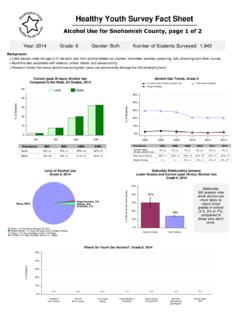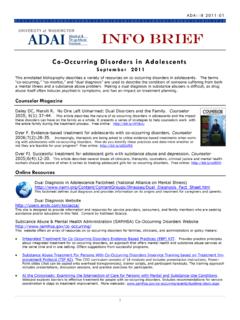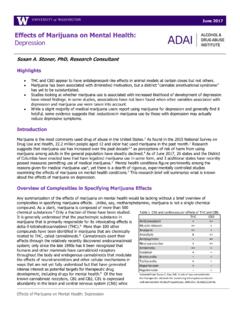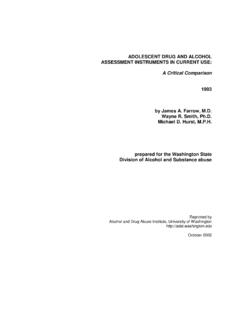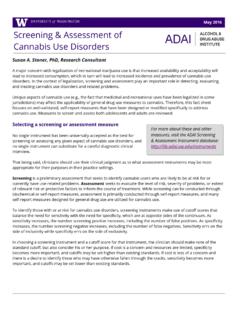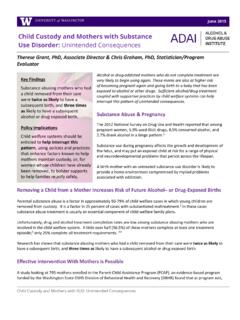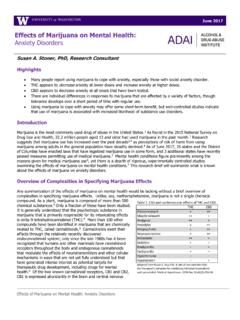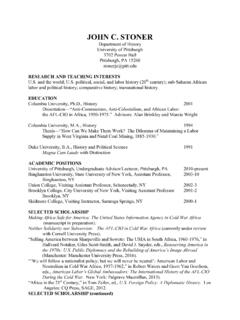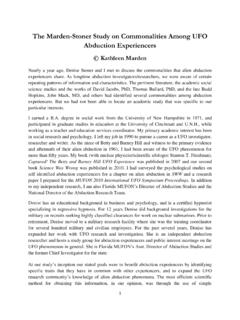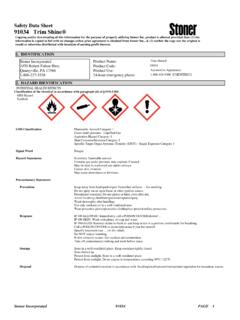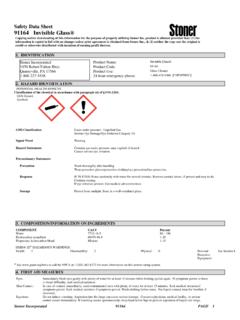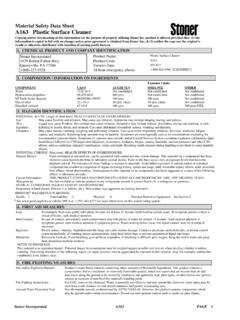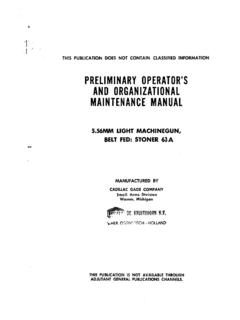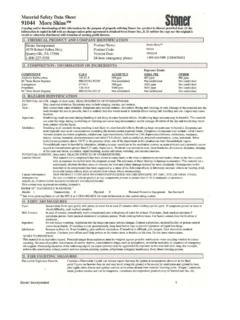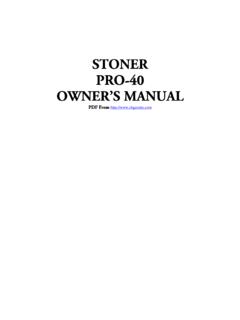Transcription of May 2016 Screening & Assessment of Cannabis Use Disorders
1 May 2016. Screening & Assessment of Cannabis Use Disorders Susan A. Stoner, PhD, Research Consultant A major concern with legalization of recreational marijuana use is that increased availability and acceptability will lead to increased consumption, which in turn will lead to increased incidence and prevalence of Cannabis use Disorders . In the context of legalization, Screening and Assessment play an important role in detecting, evaluating, and treating Cannabis use Disorders and related problems. Unique aspects of Cannabis use ( , the fact that medicinal and recreational uses have been legalized in some jurisdictions) may a ect the applicability of general drug use measures to Cannabis .
2 Therefore, this fact sheet focuses on well-validated, self-report measures that have been designed or modi ed speci cally to address Cannabis use. Measures to screen and assess both adolescents and adults are reviewed. Selecting a Screening or Assessment measure For more about these and other No single instrument has been universally accepted as the best for measures, visit the ADAI Screening Screening or assessing any given aspect of Cannabis use Disorders , and & Assessment Instrument database: no single instrument can substitute for a careful diagnostic clinical interview.
3 That being said, clinicians should use their clinical judgment as to what Assessment instruments may be most appropriate for their purposes in their practice settings. Screening is a preliminary Assessment that seeks to identify Cannabis users who are likely to be at risk for or currently have use-related problems. Assessment seeks to evaluate the level of risk, severity of problems, or extent of relevant risk or protective factors to inform the course of treatment. While Screening can be conducted through biochemical or self-report measures, Assessment is primarily conducted through self-report measures, and many self-report measures designed for general drug use are utilized for Cannabis use.
4 To identify those with or at risk for Cannabis use Disorders , Screening instruments make use of cuto scores that balance the need for sensitivity with the need for speci city, which are at opposite sides of the continuum. As sensitivity increases, the number Screening positive increases, including the number of false positives. As speci city increases, the number Screening negative increases, including the number of false negatives. Sensitivity errs on the side of inclusivity while speci city errs on the side of exclusivity.
5 In choosing a Screening instrument and a cuto score for that instrument, the clinician should make note of the standard cuto , but also consider his or her purpose. If cost is a concern and resources are limited, speci city becomes more important, and cuto s may be set higher than existing standards. If cost is less of a concern and there is a desire to identify those who may have otherwise fallen through the cracks, sensitivity becomes more important, and cuto s may be set lower than existing standards.
6 Measures to screen for Cannabis Use Disorder Below is a selection of commonly used self-report Screening instruments, with standard cuto s, ordered according to the number of items in the scale. Title, Abbrev. (Source) Severity of Dependence Scale, SDS (van der Pol et al., 2013). Reference Period Past year Target Audience Adolescents and adults Number of Items, Range 5, 0-15. Example Questions 1) Did you think your use of Cannabis was out of control? 2) Did you worry about your use of Cannabis ? Response Options (Score) Response options vary from question to question.
7 Most questions use the following: Never/almost never (0), sometimes (1), often (2), always/nearly always (3). Cut-o score 2 or above is considered a positive screen for Cannabis use disorder. Title, Abbrev. (Source) Cannabis Abuse Screening Test, CAST (Legleye et al., 2012). Reference Period Lifetime Target Audience Adolescents and young adults Number of Items, Range 6, 0-24 (full scale scoring method). Example Questions 1) Have you ever smoked Cannabis before midday? 2) Have you ever smoked Cannabis when you were alone?
8 Response Options (Score Never (0), rarely (1), sometimes (2), quite often (3), very often (4). in full scale scoring An alternative method scores each item 0 or 1 according to a threshold method). Cut-o score 6 or above using full scale scoring is considered a positive screen for 6. Cannabis use problems. Title, Abbrev. (Source) Cannabis Use Disorders Identi cation Test Revised, CUDIT-R. (Adamson et al., 2010). Reference Period Past six months Target Audience Adolescents and adults Number of Items, Range 8, 0-24.
9 Example Questions 1) How often do you use Cannabis ? 2) How many hours were you stoned on a typical day when you had Response Options (Score) Response options vary from question to question. Most questions use the following: Never (0), less than monthly (1), monthly (2), weekly (3), daily or almost daily (4). Cut-o score 8 or above is considered positive for hazardous use. 12 or above is considered positive for possible Cannabis use disorder. Screening & Assessment of Cannabis Use Disorders 2 | Page Title, Abbrev.
10 (Source) Problematic Use of Marijuana (Okulicz-Kozaryn, 2007; Piontek et al., 2008). Reference Period Lifetime, current behavior Target Audience Adolescents Number of Items, Range 8, 0-8. Example Questions 1) Have you ever skipped school classes or came late to school because of Cannabis use? 2) Do you often feel desire for Cannabis ? Response Options (Score) No (0), yes (1). Cut-o score 2 or above is considered a positive screen for Cannabis use disorder. Title, Abbrev. (Source) Cannabis Use Problems Identi cation Test, CUPIT (Bashford et al.
